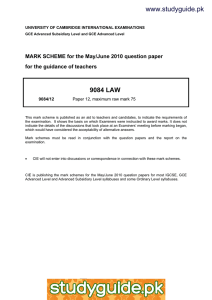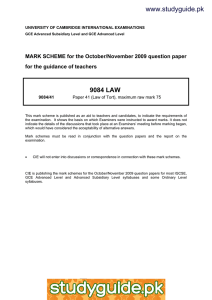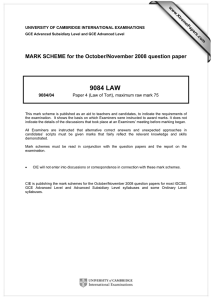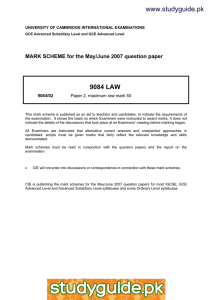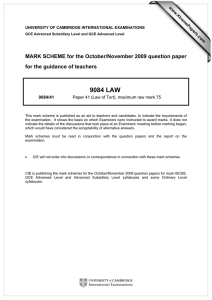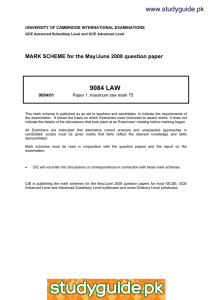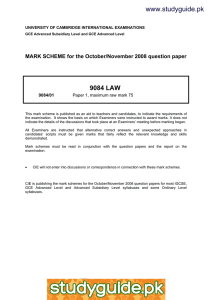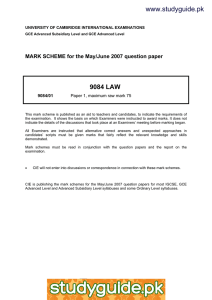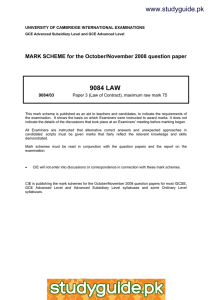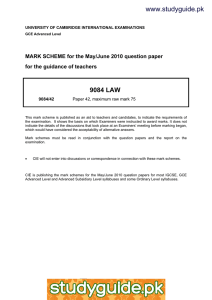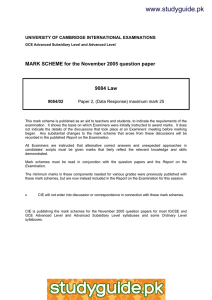www.studyguide.pk 9084 LAW
advertisement
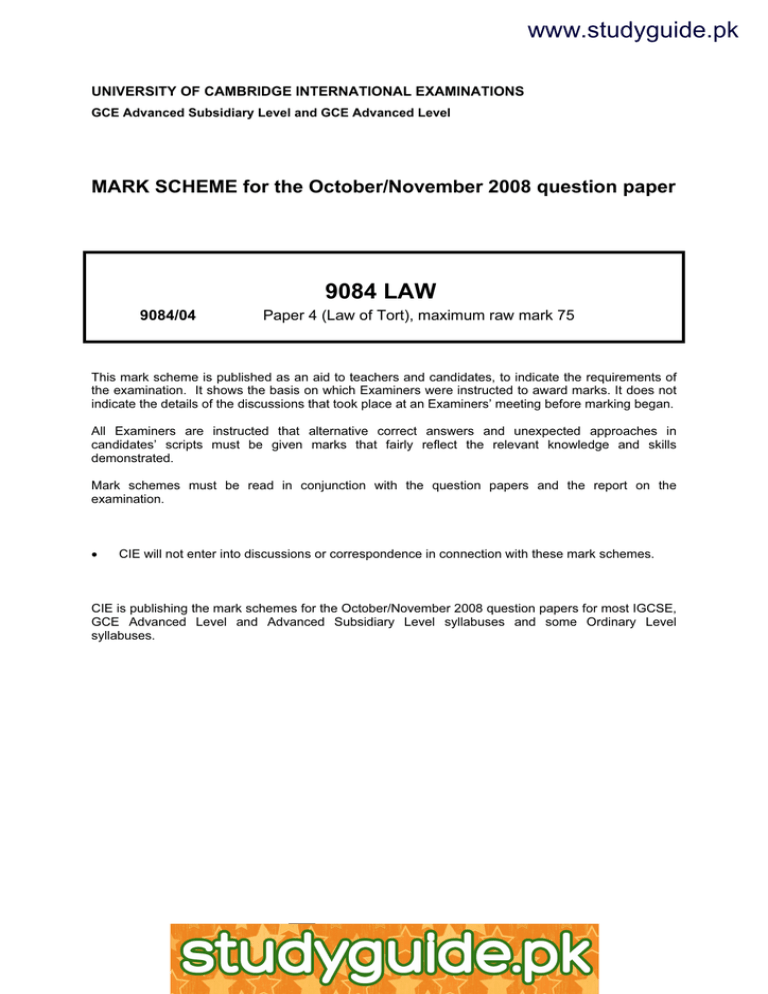
www.studyguide.pk UNIVERSITY OF CAMBRIDGE INTERNATIONAL EXAMINATIONS GCE Advanced Subsidiary Level and GCE Advanced Level MARK SCHEME for the October/November 2008 question paper 9084 LAW 9084/04 Paper 4 (Law of Tort), maximum raw mark 75 This mark scheme is published as an aid to teachers and candidates, to indicate the requirements of the examination. It shows the basis on which Examiners were instructed to award marks. It does not indicate the details of the discussions that took place at an Examiners’ meeting before marking began. All Examiners are instructed that alternative correct answers and unexpected approaches in candidates’ scripts must be given marks that fairly reflect the relevant knowledge and skills demonstrated. Mark schemes must be read in conjunction with the question papers and the report on the examination. • CIE will not enter into discussions or correspondence in connection with these mark schemes. CIE is publishing the mark schemes for the October/November 2008 question papers for most IGCSE, GCE Advanced Level and Advanced Subsidiary Level syllabuses and some Ordinary Level syllabuses. www.xtremepapers.net www.studyguide.pk Page 2 Mark Scheme GCE A/AS LEVEL – October/November 2008 Syllabus 9084 Paper 04 Assessment Objectives Candidates are expected to demonstrate: Knowledge and Understanding − recall, select, use and develop knowledge and understanding of legal principles and rules by means of example and citation Analysis, Evaluation and Application − analyse and evaluate legal materials, situations and issues and accurately apply appropriate principles and rules Communication and Presentation − use appropriate legal terminology to present logical and coherent argument and to communicate relevant material in a clear and concise manner Specification Grid The relationship between the Assessment Objectives and this individual component is detailed below. The objectives are weighted to give an indication of their relative importance, rather than to provide a precise statement of the percentage mark allocation to particular assessment objectives. Assessment Objective Paper 1 Paper 2 Paper 3 Paper 4 Advanced Level Knowledge/ Understanding 50 50 50 50 50 Analysis/ Evaluation/ Application 40 40 40 40 40 Communication/ Presentation 10 10 10 10 10 © UCLES 2008 www.xtremepapers.net www.studyguide.pk Page 3 Mark Scheme GCE A/AS LEVEL – October/November 2008 Syllabus 9084 Paper 04 Mark Bands The mark bands and descriptors applicable to all questions on the paper are as follows. Maximum mark allocations are indicated in the table at the foot of the page. Indicative content for each of the questions follows overleaf. Band 1: The answer contains no relevant material. Band 2: The candidate introduces fragments of information or unexplained examples from which no coherent explanation or analysis can emerge. OR The candidate attempts to introduce an explanation and/or analysis but it is so fundamentally undermined by error and confusion that it remains substantially incoherent. Band 3: The candidate begins to indicate some capacity for explanation and analysis by introducing some of the issues, but explanations are limited and superficial. OR The candidate adopts an approach in which there is concentration on explanation in terms of facts presented rather than through the development and explanation of legal principles and rules. OR The candidate attempts to introduce material across the range of potential content, but it is weak or confused so that no real explanation or conclusion emerges. Band 4: Where there is more than one issue, the candidate demonstrates a clear understanding of one of the main issues of the question, giving explanations and using illustrations so that a full and detailed picture is presented of this issue. OR The candidate presents a more limited explanation of all parts of the answer, but there is some lack of detail or superficiality in respect of either or both so that the answer is not fully rounded. Band 5: The candidate presents a detailed explanation and discussion of all areas of relevant law and, while there may be some minor inaccuracies and/or imbalance, a coherent explanation emerges. Maximum Mark Allocations: Question 1 2 3 4 5 6 Band 1 0 0 0 0 0 0 Band 2 6 6 6 6 6 6 Band 3 12 12 12 12 12 12 Band 4 19 19 19 19 19 19 Band 5 25 25 25 25 25 25 © UCLES 2008 www.xtremepapers.net www.studyguide.pk Page 4 Mark Scheme GCE A/AS LEVEL – October/November 2008 Syllabus 9084 Paper 04 Section A 1 Contributory negligence and volenti non fit injuria are very similar in nature and effect. Analyse these defences in tort and explain the extent to which you agree with this statement. Candidates should define the two terms and then go on to discuss their respective features as remedies. Volenti is the defence of consent and operates as a complete defence in appropriate cases and is not confined to any particular tort, although, like contributory negligence is frequently raised in the case of negligence claims. If deemed appropriate the effect of the defence is that no compensation is payable to the claimant. The conditions of the defence should be explored: Voluntary assumption of known risks. Were the risks understood (Smith v Baker; ICI v Shatwell)? Can children consent to harm? What about sportsmen and sportswomen (Condon v Basi)? What about rescuers (Chadwick v British Railways Board)? Candidates should recognise that unlike volenti, contributory negligence is only a partial defence which has the effect of reducing the amount of damages payable in accordance with the claimant’s own degree of fault (Law Reform (Contributory Negligence) Act 1945). Candidates must analyse what amounts to contributory negligence. Did the claimant take reasonable care for his own safety (Jones v Livox Quarries)? Was the claimant’s action reasonable (Sayers v Harlow UDC)? What about children (Gough v Thorne)? Candidates must analyse the two defences and assess the degree of similarity and contrast between them. Responses that are limited to factual recall, however detailed, will be restricted to band 3 marks. 2 Compare and contrast the torts of private nuisance and trespass to land. The question requires candidates to look at the similarities and differences between these two torts that affect interests in land. Both torts must be defined by candidates and those definitions should be explained. Responses should entail consideration of the following as a starting point: Private Nuisance Trespass to Land Involves an indirect interference with the enjoyment or use of land in another’s possession Involves a direct, physical interference with the possession of land Only actionable on proof of actual loss Technically actionable per se Generally needs to be continuous state of affairs to give rise to a cause of action Justifies a series of legal actions as long as it lasts Interference must be substantial to give rise to liability Isolated incidents suffice to give rise to a cause of action Must be an unreasonable interference Reasonableness of act of no consequence; even if in ignorance, liability arises © UCLES 2008 www.xtremepapers.net www.studyguide.pk Page 5 3 Mark Scheme GCE A/AS LEVEL – October/November 2008 Syllabus 9084 Paper 04 With reference to case law, analyse the extent to which the rules relating to causation and remoteness achieve their aim of compensating a claimant’s loss. Candidates might open their response by identifying that not every injury or loss caused by someone else results in the person at fault having to pay compensation. The law aims to strike a balance between ensuring that compensation is fair for claimants and not being too harsh on defendants. Candidates should then recognise that it is the rules of causation and remoteness that assists courts to achieve the desired balance. Causation and remoteness must be both defined and explained. They must then be used to show how the rules apply to either one tort in particular or across a range of them. As far as causation is concerned, the ‘but for test’ is of great significance, but in many cases, multiple causes and intervening events cloud the issue. Candidates should investigate and analyse the different approaches that courts have taken (e.g. McGhee v National Coal Board; Wilsher v Essex Area Health Authority; Hotson v East Berks Health Authority; Holty v Brigham Cowan; Fairchild v Glenhaven Funeral Services); which have proved helpful in achieving its aim and which have not? The development of the tests for remoteness also need to be traced and analysed against their aim (re Polemis; Wagon Mound; Doughty v Turner; Hughes v Lord Advocate). Responses that are limited to factual recall, however detailed, will be restricted to band 3 marks. © UCLES 2008 www.xtremepapers.net www.studyguide.pk Page 6 Mark Scheme GCE A/AS LEVEL – October/November 2008 Syllabus 9084 Paper 04 Section B 4 Shelly, Nigel, Gill and Paul have all been diagnosed as suffering from nervous shock. With reference to case law, advise Christopher regarding his liability in negligence towards each of them. Candidates should contextualize their responses by identifying negligence and nervous shock as the key issues. Negligence should not be discussed in detail as the scenario indicates that negligence has definitely taken place. The focus of the response should reference the liability of the defendant for nervous shock. Candidates should then distinguish between primary and secondary victims of negligence and conclude that all claimants are secondary victims. Nervous shock should be defined and the principles on which liability rests as regards secondary victims should be identified and explained: relevant class of person, own sight, hearing of incident or its immediate aftermath, means by which shock received. These should then be related to each claimant separately. Shelley is a sibling so the Alcock requirement of a tie of love and affection can be presumed and she was actually at the scene of the accident and saw it happen. Nigel was also present, but as a friend will have more difficulty, having to prove a tie akin to a family relationship (Alcock). Could his claim flounder? Although Gill is her mother, the findings in Alcock suggest that identifying her body at the hospital will not satisfy the aftermath test. Will her claim fail? As for Paul, the issue here is the means by which he learned of the accident. In Alcock it was suggested that clearly identifiable live pictures might satisfy the proximity requirement. Whatever conclusions are reached they should be clear, compelling and fully supported. 5 With reference to appropriate statute and case law, advise Philippe regarding his liability for the injuries sustained by Elise, Michel and Louis. Candidates should identify Occupiers’ Liability as the context of this scenario. The relevant provisions of the Occupier’s Liability Act 1957 and 1984 should be stated, explained and applied. Is Philippe an occupier in law (Wheat v Lacon)? If so, what duty does S2 of the 1957 Act impose on him as regards lawful visitors? What standard is applied to measure whether reasonable safety has been assured? Does the standard alter in respect of children who visit? Should child visitors be supervised (Phipps v Rochester Corp,; Simkiss v Rhondda BC)? How does this apply to Elise? Is Philippe liable for the actions of independent contractors? Has he chosen his contractors wisely? Has he taken sufficient steps to ensure that they do their work properly? Michel is a courier who visits private premises on a regular basis. Should he be more aware and take greater care for his own safety? Has he contributed to his own injuries? Is Louis a lawful or unlawful visitor? Entry under the cover of darkness suggests the latter unless he has been given permission by Philippe. If a trespasser, the 1984 Act applies and candidates need to discuss the duties imposed on Philippe by that Act too. Whatever conclusions are reached they should be clear, compelling and fully supported. © UCLES 2008 www.xtremepapers.net www.studyguide.pk Page 7 6 Mark Scheme GCE A/AS LEVEL – October/November 2008 Syllabus 9084 Paper 04 With reference to case law, assess the potential liability in tort of both John and Michael. Candidates should set their response in context by explaining that the tort of trespass has three forms: to land, to the person and to goods. This problem concerns trespass to the person, which can also take three forms: assault, battery and false imprisonment. Candidates should offer clear, concise definitions and brief explanations of the first two as these are the two relevant to the scenario. Candidates should then address the four potential issues arising from the facts of the scenario. Could Michael’s verbal abuse and threats following the first heavy tackle amount to an assault? In general, words alone will not amount to an assault unless accompanied by threatening actions as they should not create reasonable fear that a battery is imminent (Thomas v National Union of Mineworkers). Does John kicking Michael while he is on the ground amount to a battery? It would appear that any intentional, unlawful infliction of physical force amounts to a battery (Wilson v Pringle). Or could this be interpreted as an act of self-defence, perhaps? The extent of liability ought to be considered too and whether the defence of consent might apply. The principles must be applied to the scenario and clear, compelling and fully supported conclusions drawn. © UCLES 2008 www.xtremepapers.net

